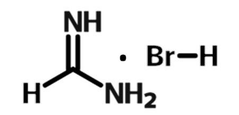Formamidinium Bromide (FABr)
CAS Number 146958-06-7
Materials, Perovskite Materials, Perovskite Precursor MaterialsFormamidinium bromide, perovskite precursor material for FAPbBr3
Fast and free worldwide shipping available for qualifying orders
Overview | Specifications | MSDS | Pricing and Options | Literature and Reviews | Resources and Support
Formamidinium bromide (FABr), is used mainly as a perovskite precursor material for FAPbBr3 or a range of formamidinium lead bromide-iodide mixed halide perovskites (FAPbIyBr3-y). FAPbBr3 material, having an energy bandgap of 2.23 eV, makes it an ideal candidate for tandem solar cell applications as well.
General Information
| CAS number | 146958-06-7 |
| Chemical formula | CH5BrN2 |
| Molecular weight | 124.97 g/mol |
| Synonyms | FABr, Formamidine hydrobromide |
| Classification / Family |
Perovskite precursor materials, Perovskite solar cells Light-emitting diodes. |
Product Details
| Purity |
99% >99% (further purified by double recrystallization from 98% grade in ethanol) |
| Melting point | 133-140 °C |
| Color | White powder/crystals |
Chemical Structure

Applications
Formamidinium bromide (FABr), is used mainly as a perovskite precursor material for FAPbBr3 or a range of formamidinium lead bromide-iodide mixed halide perovskites (FAPbIyBr3-y). With a combination of different ratios of halides in the perovskite structure, it is possible to tune the the bandgap of the formamidinium lead trihalide system between 1.55 eV and 2.3 eV. This can enable variation in color, extending the photoexcited species lifetime, enhancing charge transport through the layer and thus an optimization for applications in multi-junction solar cells [1, 2].
FAPbBr3 material, having an energy bandgap of 2.23 eV [1], makes it an ideal candidate for tandem solar cell applications as well.
| Device structure | FTO/TiO2/FAPbBr3/Spiro-OMeTAD/Au [1] | FTO/TiO2/MAPbBr3/Spiro-OMeTAD/Au [1] |
| Jsc (mA cm-2) | 6.6 | 0.6 |
| Voc (V) | 1.35 | 1.48 |
| FF (%) | 0.73 | 0.48 |
| PCE (%) | 6.5 | 0.4 |
| Device structure | FTO/TiO2/FAPbIBr2/Spiro-OMeTAD/Au [2] |
| Jsc (mA cm-2) | 23.3 |
| Voc (V) | 0.94 |
| FF (%) | 65 |
| PCE | 14.2 |
MSDS Documentation
Formamidinium bromide MSDS sheet
Pricing
| Grade | Order Code | Quantity | Price |
| 99% purity | M562 | 10 g | £160 |
| 99% purity | M562 | 25 g | £280 |
| >99% purity | M561 | 5 g | £180 |
| >99% purity | M561 | 10 g | £300 |
Literature and reviews
- Efficient Planar Heterojunction Perovskite Solar Cells Based on Formamidinium Lead Bromide, F. C. Hanusch et al., J. Phys. Chem. Lett., 5 (16), 2791–2795 (2014), DOI: 10.1021/jz501237m.
- Formamidinium lead trihalide: a broadly tunable perovskite for efficient planar heterojunction solar cells, G. E. Eperon et al., Energy Environ. Sci., 7, 982-988 (2014), DOI: 10.1039/C3EE43822H.
- Compositional engineering of perovskite materials for high-performance solar cells, N. Jeon et al., Nature 517, 476–480 (2015), doi:10.1038/nature14133.
